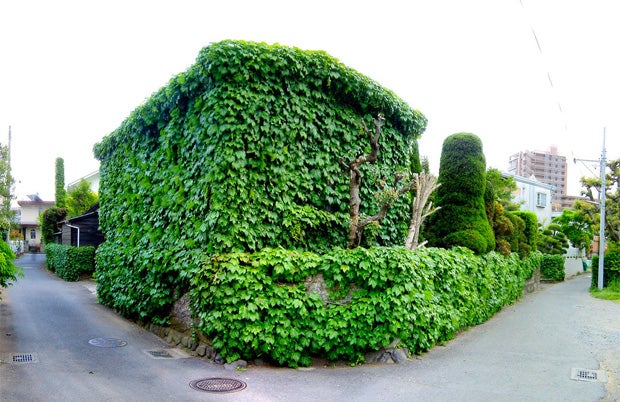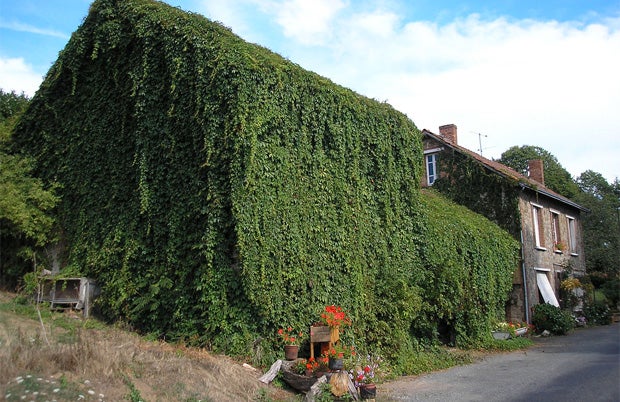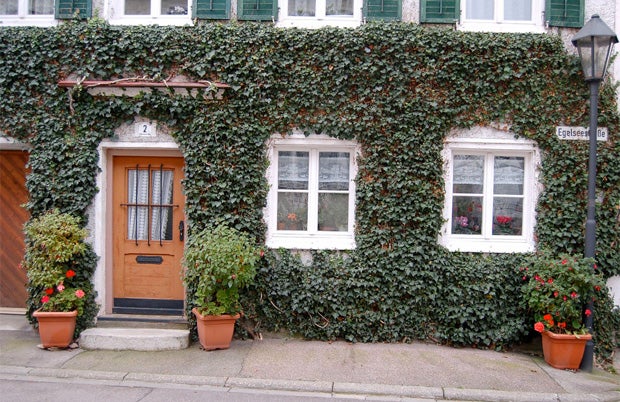Is ivy helping or harming the structures it covers?
ListenMike McGrath guides listeners in correcting damage to their hostas, understanding strawberry varieties, how to prune evergreens, caring for aging rose bushes, tips and tricks to composting, and the pros and cons of growing climbing ivy.
Question of the Week:
Mike: Does English Ivy damage structures? Web searches have turned up mixed answers. Some on campus want it off; others like the way it looks. The buildings in question are mostly wood, some masonry, approximately 100 to 150 years old. Our carpenter is concerned that the ivy is holding moisture and providing a highway for ants and other destructive insects to get to the wood, which never gets sun or a breeze, and is always damp. Thanks,
— Andy; Director of Facilities; Ursinus College; Collegeville, PA
Learn how and where to grow climbing ivy »
Slideshow below: Climbing ivy do’s and don’ts
Highlights from show for June 29, 2013:
Protecting your hostas
Gloria from La Vergne, Tennessee is concerned about tiny holes appearing in the leaves of her plants, especially her hostas and roses. “When people tell me they have problems with their hostas, there are two things that immediately come to mind,” Mike says, “if large parts of the plants are missing, it’s deer. If there are holes in the leaves it’s generally slugs, but slugs make pretty big ragged holes in the leaves.” He encourages Gloria to do a test for the slugs and put out a few shallow containers of beer out in the garden in the evening and check in the morning if any slugs are around. In addition, she can buy an organic insecticide either called Neem or any product with Spinosads in it to spray on the leaves of her plants.
“When people tell me they have problems with their hostas, there are two things that immediately come to mind. If large parts of the plants are missing, it’s deer. If there are holes in the leaves it’s generally slugs, but slugs make pretty big ragged holes in the leaves.”
Mike McGrath
-
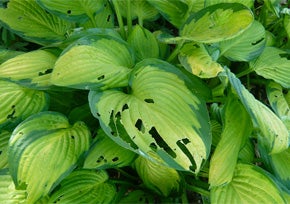
Slug damage. Photo by Flickr user Brian Pettinger
Strawberry varieties
John in Manayunk, Pennsylvania has a garden of strawberries that seemingly out of nowhere turned stark white. Even though they are eventually turning red, they just don’t taste the same. Mike explains that there are two kinds of strawberries: the June-bearing type, which is only active a few weeks around June, and the Everbearing type, which are smaller but they bloom the entire summer. Since it sounds like John has June-bearing strawberries, “it is not unusual for the last run of something like this to get blanched out.” The extremely hot week that the plants endured recently may also play a role, but John can grow some Ever-bearing strawberries and keep his fruit growing all summer if he wants to!
Don’t chop the tops of your arborvitae!
Chuck has eight arborvitaes in Bryn Mawr, Pennsylvania that he would care for in the winter by knocking off all the snow to keep the tree from bending. However, as the tree has grown over twenty feet, he can no longer reach the tops to clear the snow. Chuck called a tree service to cut down the tops of the trees. “You should be angry at the tree service, I know people have to make money, but there comes a time when you need to be a professional,” Mike emotionally states. “For them not to have warned you that this was child endangerment almost seems criminal to me.” It should be uprooted, as it will never grow normally and will die prematurely. Chuck can also look into other trees like the Leyland Cypress or other arbor vitaes varieties that can better handle snow and don’t grow larger than the 12-14 feet that he would like.
Caring for aging rosebushes
Irene in Burlington County, New Jersey has an old rose bush that is at least 70 years old that is just now developing an abnormal cane growth. After ruling out the possibility of the rose bush virus, Mike determines that another factor that may be contributing is Irene’s pruning in the fall. “This is a senior citizen! So there’s probably not a lot of gas left in the tank. The senior citizen is trying to send its remaining energy down to its root system to survive the winter, meanwhile your pruning forces it to grow instead, kind of slapping it awake when it wants to go to sleep,” Mike explains. Irene can change her pruning times to be in the beginning of the summer and spread an inch of compost all around the bush to restore some nutrients and energy.
-
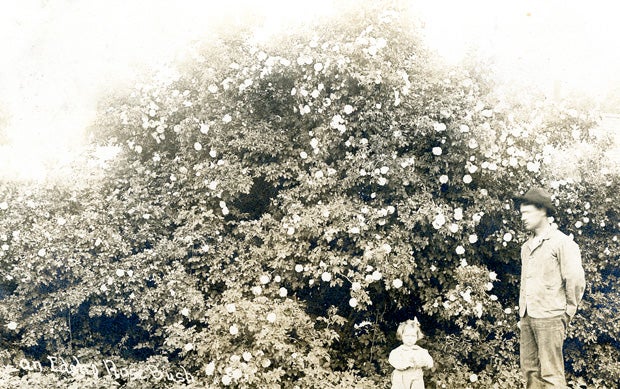
Rose bush, 1912. Photo by Flickr user WaterArchives.org
Rollie pollies in your compost are helping not hurting
Vern has some compost questions about his garden in Allentown, Pennsylvania. He’s been finding beetle shaped bugs in his compost bin and around some of his plants outside. Mike deduces that these bugs are probably rollie pollies which are decomposers that aid in the composting process. “A lot of people like to consider them pests, I cannot,” Mike explains. In truth, these bugs are often at the scene of the crime in a garden, but have most likely gotten there after the damage has already occurred. “The good news is that these creatures are largely benign,” Mike says. They are in fact not doing any damage, but actually moving the garden along in its growing.
Coffee in your compost
Ed from Willingboro, New Jersey is concerned that his fall leaves are not fully breaking down in his compost pile. Although they are partially shredded from being collected with his riding mower, Ed continues to find large chunks of leaves in his pile that haven’t broken down over his compost season. Mike advises Ed to turn his compost pile with a pitchfork every once in awhile to help advance the process. In addition to this, Mike shares one simple trick to get things moving: coffee grounds. Mike explains: “Coffee grounds are the perfect addition to shredded leaves. Shredded leaves and coffee grounds together make the best compost, and I guarantee your compost will be made faster. More of your leaves will become compost because the nitrogen in the coffee grounds will feed the living organisms that fuel the composting process.” Mike further recommends that if Ed has a large compost pile, that he should visit local coffee shops and collect their discarded grounds in bulk.
“Coffee grounds are the perfect addition to shredded leaves. Shredded leaves and coffee grounds together make the best compost, and I guarantee your compost will be made faster.”
Mike McGrath
-

Photo by Flickr user Amber Karnes
Ridding your plants of mystery pests
Bob from Jim Thorpe, Pennsylvania is concerned about the health of his mugo pine tree. He describes to Mike a strange white foam that’s appearing at the base of the pine needles of the tree, and he’s further perplexed by the small black beetles that are hanging out on the foam. After his initial round of questioning, Mike uncovers the fact that Bob sprayed this tree with vinegar to get rid of caterpillars on it two years ago, and Mike explains that this was the wrong way to go. Vinegar acts as an herbicide and should be sprayed on weeds or plants that you don’t want around anymore; spraying vinegar on a tree like this severely weakens the health of the tree. To organically rid trees of insects, Mike advises to spray instead an insecticidal soap or horticultural oil. For Bob’s particular problem though, Mike first recommends rigorously spraying the tree with water. He advises Bob to spray down the branches of the tree intensely every morning for a few days up to a week to remove all traces of this foam/bug combo. If this damage crops up again, Mike advises Bob to contact his local extension service for help in identifying exactly what type of insect this is. Accurately identifying the pest is the best way to start in getting rid of it.
— This week’s post was written by Jolie Higazi, You Bet Your Garden Intern
WHYY is your source for fact-based, in-depth journalism and information. As a nonprofit organization, we rely on financial support from readers like you. Please give today.





